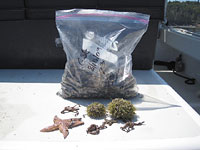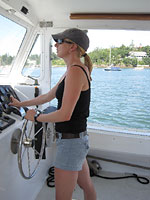

 | |||||||||||||
|
|
Journals 2009/2010Jennifer Emblidge
August 19, 2009 Today, I got up at 5 a.m. in order to make it to Rockland, ME by 7 a.m. We went out on a lobster boat today for the 1-week post-release sampling event. This means that the Wahle lab dive crew went out to re-visit the same four release sites in Penobscot Bay that we went to last Wednesday. Our boat captain today was named Tony Fitch. He is actually an old intern of Rick's and he took us out on a large lobster boat, the Man-O-War, that is owned by a friend of his. The post-release sampling event is performed in order to monitor the success of the hatchery-released lobsters. It is a very cool process! First, we traveled to the first site called Oak's Point. Two dive partner teams composed of Mahima and Rick and then Charlene and Lee got dressed in all their diving gear. Next, they entered the water and it was my responsibility to hand them over their 1 m2 sampling quadrats, their collection bags, and finally the suction sampler. The teams arranged themselves in the middle of the sampling area that is approximately 50 meters long and 10 meters wide at every site. Each team traveled to opposite ends of this area. As each team traveled, they randomly placed the quadrat on the ocean floor. Once the quadrat was placed on the bottom, the dive team used the suction sampler to vacuum up everything from the ocean bottom that was found within the 1 m2 area. The suction sampler takes up everything in its way including rocks, shells, lobsters, fish, and sea stars just to name a few.
The suction sampler is a very neat device. It consists of a long PVC pipe that is connected at one end to a SCUBA tank and at the other end to a sample bag. One end is placed on the bottom, the air tank is turned on, and the apparatus begins to suck up the sample into the bag at the other end. Each time team filled up a total of 20 sample bags at each of the four sites for a total of 80 sample bags for the day. My job took place on the surface again today. I was not only there to hand down the equipment to the teams but also to pick it up and placed in back on the boats in between sites. The SCUBA tanks started to get real heavy, REALLY FAST. My other job which was much more exciting, involved placing the samples into labeled zip-lock bags in coolers. I got the awesome job of moving critters like brittle stars, sea stars, fish, crabs, and lobsters from the sampling bags into the sorting bags. Tomorrow, we will begin the sample sorting of all of these bags when we are back in the lab.
In all, the dive teams went on a total of four dives each. Each dive was about 45 minutes long at a depth of around 16 ft. I also filled out the diving logs for the divers today. We returned to shore by about 2:30 p.m., so it was a very speedy and smooth trip for the divers today. It was an absolutely perfect day to spend on the water because it was about 90 degrees back on land without a cloud in the sky. I was glad I packed my sunscreen that's for sure! My favorite part of the day was that I got to drive the big lobster boat back to shore. Check out my picture below!
|
||||||||||||


